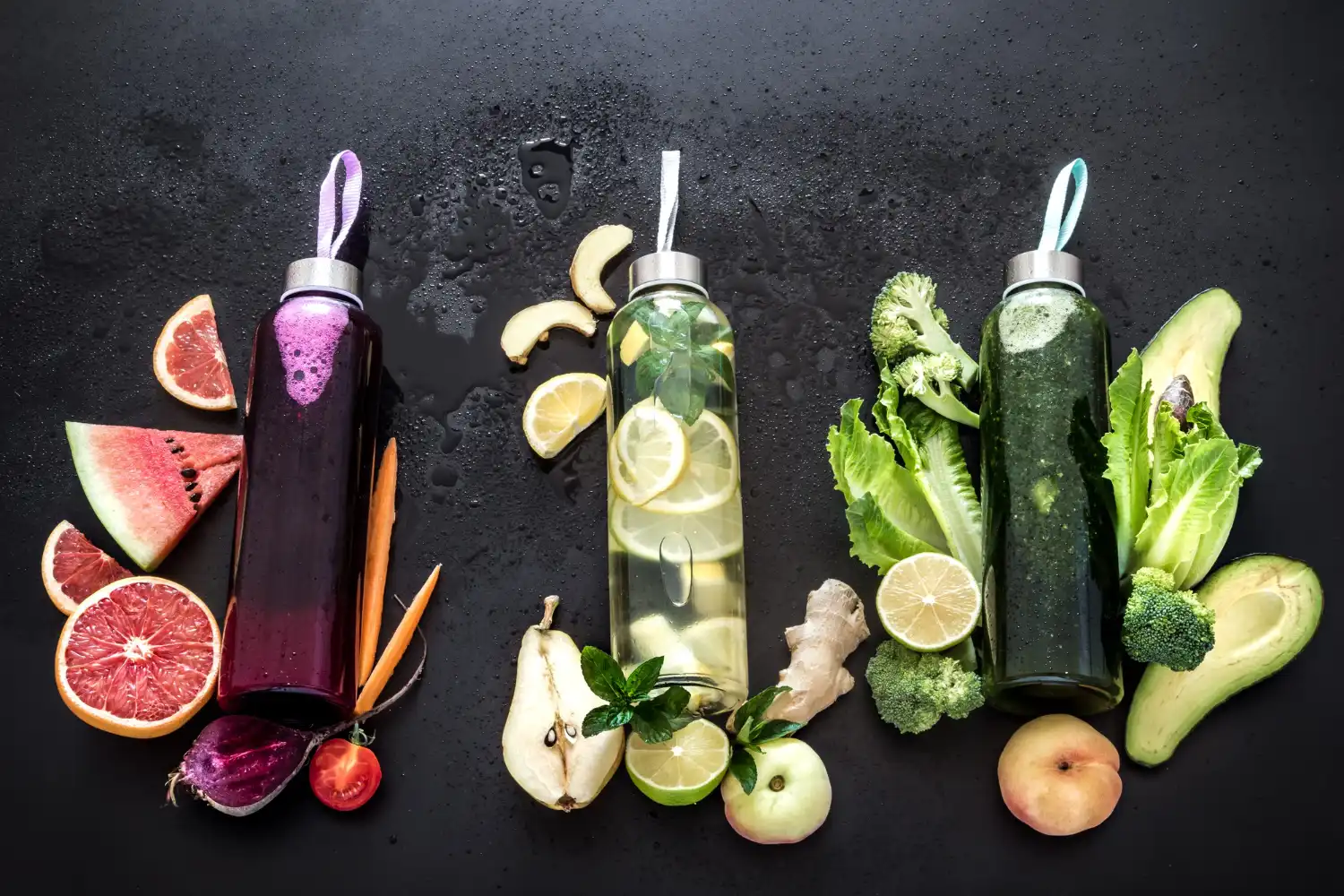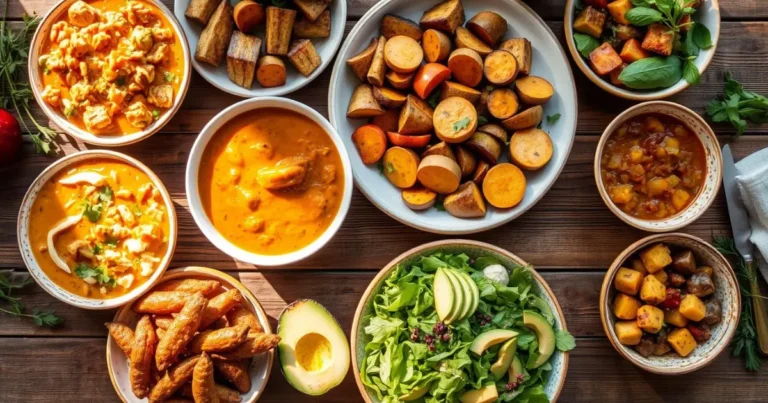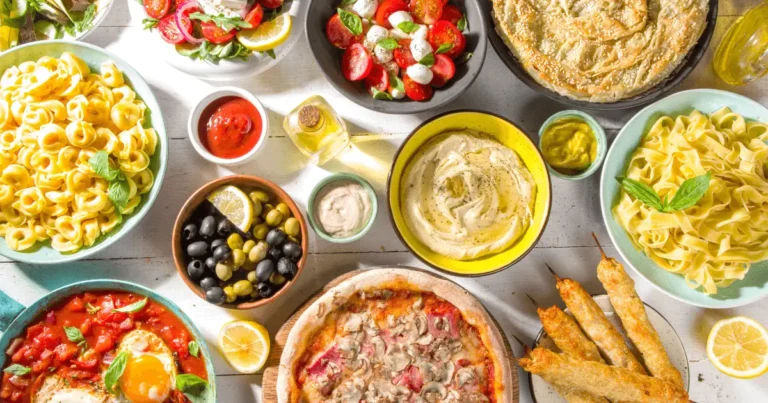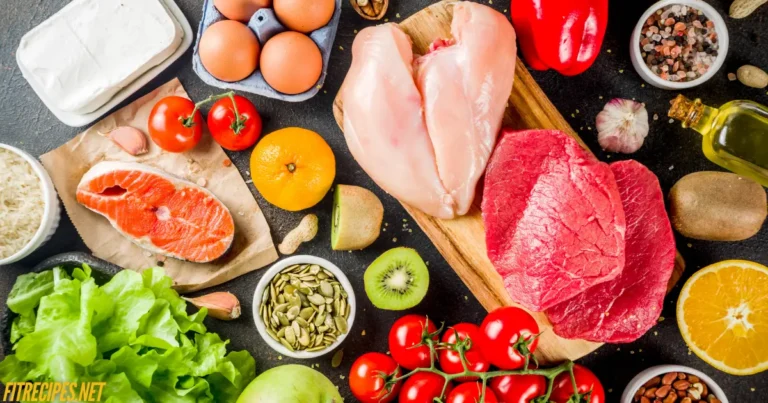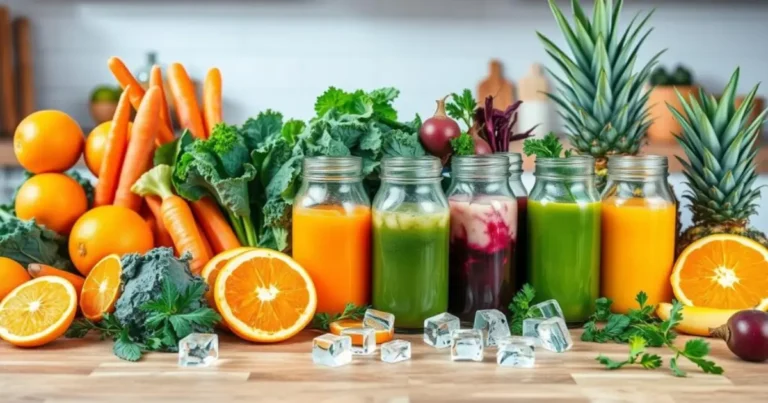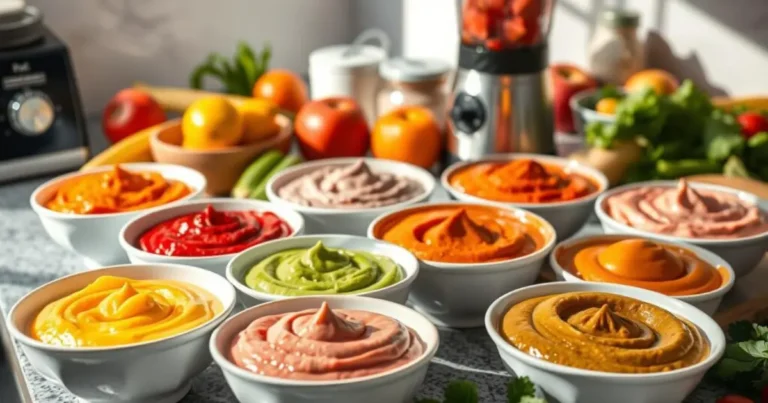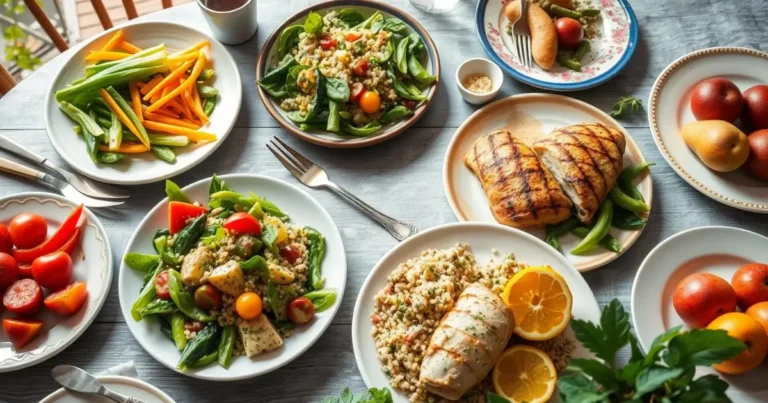Full liquid diet foods: What to eat and avoid
Starting a full liquid diet means knowing what foods are okay and what to skip. This diet is all about smooth, liquid foods that are easy to digest. It’s often recommended for people recovering from surgery or with digestive problems.
If you’re on a full liquid diet for health reasons or after surgery, it’s key to know the rules. We’ll cover what a full liquid diet is, why it’s used, and the best foods to eat.
Table of Contents
Key Takeaways
- A full liquid diet consists of easily digestible, smooth, and liquid-based foods.
- This type of diet is often prescribed for individuals recovering from medical procedures or dealing with digestive issues.
- Understanding the guidelines for a full liquid diet is crucial to make informed food choices.
- Dairy-based liquids, fruit and vegetable juices, and smooth soups are essential full liquid diet foods.
- Avoiding solid foods and sticking to the prescribed diet is essential for a successful recovery.
Understanding the full liquid diet: Definition and purposes
A full liquid diet mainly includes liquids or foods that can be easily turned into liquids. It’s often suggested for those recovering from surgery, dealing with digestive problems, or having trouble eating solid foods. The goal is to give the body the nutrients it needs while it heals.
Medical Reasons for Following a Liquid Diet
Healthcare experts may recommend a full liquid diet for several reasons. These include:
- Post-operative recovery, such as after gastrointestinal surgery or dental procedures
- Swallowing difficulties (dysphagia) due to conditions like stroke, Parkinson’s disease, or cancer
- Severe nausea or vomiting, as seen in conditions like gastroenteritis or pancreatitis
- Digestive issues, such as Crohn’s disease, ulcerative colitis, or diverticulitis, to allow the intestines to rest and heal
Duration and Dietary Restrictions
The length of a full liquid diet varies based on the medical condition and the person’s progress. It might last a few days or weeks, or even longer. People on this diet should avoid solid foods and stick to liquids like broths, juices, and smoothies.
Remember, a full liquid diet is not meant to be a long-term solution. It should only be followed with a doctor’s advice. Going back to a regular, balanced diet is key for staying healthy.
Benefits and limitations of following a liquid diet
A full liquid diet can be very helpful for people recovering from surgery or dealing with digestive problems. It’s easy to digest and helps your body absorb nutrients better. Liquid foods are kinder to your stomach, making it easier to heal.
But, there are downsides to a liquid diet. You might not get enough fiber, which can cause constipation or stomach pain. Also, eating only liquids can get boring and hard to stick to for a long time.
Remember, starting a full liquid diet should only be done with a doctor’s advice. They can make sure you’re getting the right nutrients and staying healthy while you’re recovering.
- Improved digestion and nutrient absorption
- Reduced strain on the gastrointestinal system
- Potential for constipation or other digestive issues due to low fiber
- Monotony of a liquid-only diet can be challenging to maintain
- Medical supervision is essential for a safe and effective liquid diet
Essential full liquid diet foods to include in your meal plan
If you’re on a full liquid diet, it’s key to pick foods that are full of nutrients. These foods help your body get what it needs without hard chewing or digestion. Here are the main types of full liquid diet foods to add to your meals.
Dairy-based Liquids and Alternatives
Dairy like milk, yogurt, and cottage cheese are great for protein and calcium. For those who can’t do dairy, try soy, almond, or oat milk. Smooth custards and puddings are also good for your diet.
Fruit and Vegetable Juices
Adding different fruit and vegetable juices to your diet is a good idea. Choose juices that are smooth and without pulp, like apple or grape juice. Vegetable juices like carrot or spinach are also good and easy on your stomach.
Smooth Soups and Broths
Smooth soups and broths are perfect for a liquid diet. Stay away from soups with solid pieces and go for pureed ones like mushroom or butternut squash. These can keep you hydrated and give you important nutrients.
It’s important to keep your diet varied and balanced. It guarantees you receive the necessary nutrients. Talk to your doctor or a dietitian to make a meal plan that fits your needs.
| Dairy-based Liquids | Fruit and Vegetable Juices | Smooth Soups and Broths |
| Milk (cow, soy, almond, oat) | Apple juice | Cream of mushroom soup |
| Yogurt (Greek, regular) | Grape juice | Butternut squash soup |
| Cottage cheese | Tomato juice | Chicken broth |
| Custards and puddings | Carrot juice | Vegetable broth |
Foods to avoid on a full liquid diet
Following a diet liquid food regimen means avoiding certain foods. These foods can hinder the goals of a full liquid diet options. The restrictions help with healing, nutrient absorption, and health during recovery or transition.
Here are some foods to avoid on a full liquid diet:
- Solid foods – Avoid anything that needs chewing, like meat, veggies, and whole grains. They’re hard to digest and may cause discomfort.
- Chunks and pulp – Steer clear of foods with a thick texture, like chunky soups, fruit or veggie pieces, and smoothies with seeds or skins. They can be hard to digest.
- Fibrous foods – Foods high in fiber, such as raw fruits and veggies, whole grains, and nuts, are tough to digest. They may upset your stomach.
Choose smooth, creamy, and easy-to-digest diet liquid food options. These should provide the nutrients you need without straining your digestive system. Options include milk, yogurt, custards, puddings, ice cream, and clear broth-based soups.
| Allowed Full Liquid Diet Foods | Foods to Avoid |
| Milk and milk-based products (e.g., yogurt, pudding, custard)Fruit and vegetable juices (strained to remove pulp)Smooth soups and broths Ice cream, sherbet, and popsicles Smoothies made with allowed ingredients | Solid foods (e.g., meat, vegetables, whole grains)Chunky or pulpy foods (e.g., chunky soups, fruit with skins or seeds)Fibrous foods (e.g., raw fruits and vegetables, nuts) |
The goal of a full liquid diet options is to give you enough nutrition without stressing your digestive system. By picking the right diet liquid food options, you help your body heal. You’ll be ready to eat a more varied diet when the time comes.
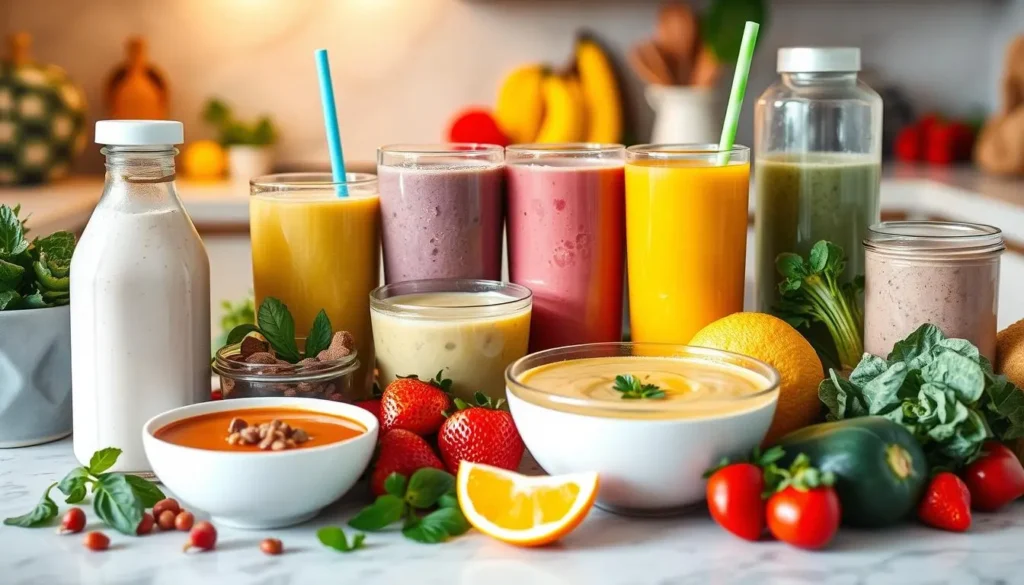
Nutritional considerations and supplements
When on a full liquid diet, it’s key to keep your nutrition in check. This diet is used for health reasons or personal choice. Knowing how to get enough calories, nutrients, and protein is vital for staying healthy and full of energy.
Meeting Daily Caloric Needs
One big worry with a full liquid diet is getting enough calories. Liquids are easy to digest but might not fill you up like solid foods. Choose liquid diet ideas that are packed with nutrients, like protein shakes and fortified juices, to keep you fueled.
Essential Nutrients and Vitamins
A full liquid diet might not give you all the vitamins and minerals you need, like fiber and iron. You might need supplements to get what you need. Talk to your doctor about what supplements are best for you.
Protein Requirements
Getting enough protein is very important on a full liquid diet. It helps keep your muscles strong and helps with healing. Add foods high in protein, like Greek yogurt and protein powders, to your diet to meet your protein needs.
By choosing nutrient-rich liquid diet ideas and working with your healthcare team, you can manage a full liquid diet well. This way, you can keep your health and well-being in top shape.
Sample meal plan for a full liquid diet
Starting a full liquid diet after surgery or illness can be tough. But, with the right meal plan, your body will get the nutrients it needs. Here’s a daily menu that shows you the variety of liquid diet foods after surgery and diet liquid food options.
Breakfast
- 1 cup of smooth yogurt
- 1/2 cup of pureed fruit (such as applesauce or mashed bananas)
- 1 cup of warm milk or nutritional supplement drink
Lunch
- 1 cup of cream-based soup (such as tomato or mushroom)
- 1/2 cup of strained fruit juice
- 1 cup of smooth pudding or custard
Dinner
- 1 cup of pureed vegetables (such as mashed sweet potatoes or butternut squash)
- 1 cup of clear broth
- 1/2 cup of dairy-based smoothie
Snacks
- 1/2 cup of ice cream or frozen yogurt
- 1 cup of milk or milk-based supplement
- 1/2 cup of strained fruit or vegetable juice
Remember, the amount of food you eat may change based on your needs. It’s key to work with your healthcare team to make a full liquid diet plan that helps you recover and stay healthy.
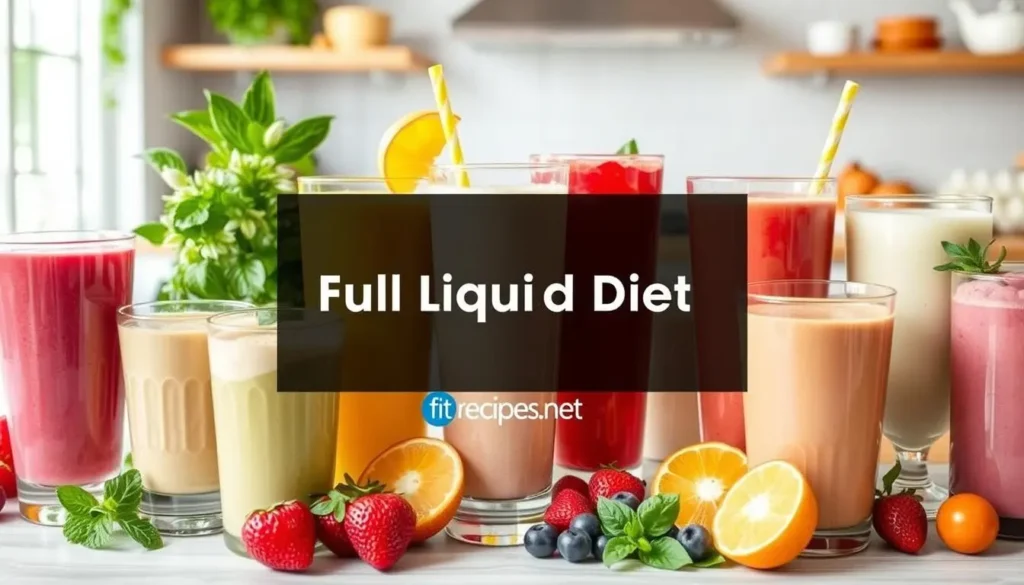
| Meal | Food Items | Calories |
| Breakfast | Yogurt, pureed fruit, milk | 350 calories |
| Lunch | Cream-based soup, fruit juice, pudding | 400 calories |
| Dinner | Pureed vegetables, broth, smoothie | 300 calories |
| Snacks | Ice cream, milk, juice | 250 calories |
| Total | 1,300 calories |
This full liquid diet menu offers a balanced and nutritious way to meet your daily needs. Always check with your healthcare provider to make sure this plan fits your dietary needs.
Tips for preparing full liquid diet foods at home
Starting a full liquid diet can be a big change. But, with the right tools and methods, you can make tasty and healthy meals at home. Knowing what kitchen tools you need and following safety tips will help. This way, your meals will be both good for you and enjoyable to eat.
Kitchen Equipment Essentials
To make a variety of full liquid diet foods, you’ll need some important kitchen items. A strong blender or food processor is key for smooth textures. Choose one with adjustable speeds for different ingredients. An immersion blender is also handy for blending soups and sauces right in the pot.
Storage and Safety Guidelines
Keeping your food safe and fresh is crucial on a full liquid diet. Put all your prepared meals in airtight containers in the fridge. Eat them within 3-4 days for the best taste and safety. When you reheat your meals, make sure they’re hot all the way through to kill bacteria.
Don’t leave your food out for too long, and throw it away if it smells bad or looks off. By using the right kitchen tools and following these storage and safety tips, you can make a variety of liquid diet ideas and full liquid diet foods at home. A bit of creativity and care will make your full liquid diet delicious and healthy.
Transitioning from clear liquids to full liquid diet foods
Switching from clear liquids to full liquid foods is a big step in your recovery. It lets you slowly add more nutritious foods to your diet. But, it’s important to do this carefully and with your doctor’s help.
Start by adding small amounts of full liquid foods like smooth soups and milk drinks. Also, try pureed fruits and veggies. Watch how your body reacts, looking for any signs of trouble. As you get used to it, you can eat more and try different foods.
Talking to your healthcare team is key during this time. They can guide you on when and how to add new liquid diet options and diet liquid food. They help make sure you’re getting the right foods for your health and recovery.
FAQ
What is a full liquid diet?
A full liquid diet includes foods that are easy to digest, like liquids or semi-liquids. It’s often recommended for people recovering from surgery or with certain health issues. It helps the digestive system rest and heal.
What are the common reasons for following a full liquid diet?
You might need a full liquid diet after surgery, if you have digestive problems, or if swallowing is hard. It’s also used during treatments like chemotherapy. It’s a way to nourish you while your digestive system heals.
How long does a full liquid diet typically last?
How long you’re on a full liquid diet varies. It can be a few days or weeks. Your healthcare team will guide you as you move back to solid foods.
What are the benefits and limitations of a full liquid diet?
A full liquid diet is easier on your digestive system. It helps you absorb nutrients better. But, it might lack fiber and feel monotonous. Always follow it with your doctor’s advice to avoid nutritional gaps.
What foods are allowed on a full liquid diet?
You can have milk, yogurt, ice cream, puddings, and smooth soups. Also, fruit juices and smoothies are okay. But, avoid solid foods and anything with pulp or fiber.
What foods should be avoided on a full liquid diet?
Stay away from solid foods and anything with chunks. Also, avoid foods with pulp or fiber, like whole fruits and veggies. These can be hard to digest and cause discomfort.
How can I ensure I get the necessary nutrients on a full liquid diet?
Eat a variety of dairy, protein-rich liquids, and nutrient-dense juices and smoothies. You might need supplements to get all the vitamins and minerals you need.
Can I prepare full liquid diet foods at home?
Yes, you can make full liquid diet foods at home. Use a blender or food processor to puree meals. Just remember to follow food safety rules and store your food properly.
How do I transition from a clear liquid diet to a full liquid diet?
Start slowly when moving from a clear liquid diet to a full liquid diet. Add small amounts of full liquid foods and watch how your body reacts. Then, gradually add more variety and quantity to your diet.

